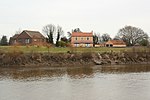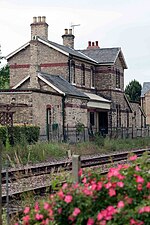East Stockwith

East Stockwith is a village within the civil parish of East Stockwith, in the West Lindsey district of Lincolnshire, England. It lies on the River Trent, 3 miles (4.8 km) north-west of Gainsborough. The River Trent Aegir, a tidal bore, reaches the village. In 2001 it had a total resident population of 209, increasing to 314 at the 2011 census.The hamlet and former civil parish of Walkerith, about 1.5 miles (2.4 km) to the south, is within East Stockwith parish.Opposite East Stockwith on the River Trent is West Stockwith, a large village within the county boundaries of Nottinghamshire. The two villages were once connected by a ferry which stopped in 1953.The village contains a church, a pub, The Ferry House, and two large arable farms growing mainly wheat and potatoes. The nearest town with schools and shops is Gainsborough. Local leisure activities include angling on the Trent, particularly for eels, and horse riding.
Excerpt from the Wikipedia article East Stockwith (License: CC BY-SA 3.0, Authors, Images).East Stockwith
Carr Lane, West Lindsey East Stockwith CP
Geographical coordinates (GPS) Address Nearby Places Show on map
Geographical coordinates (GPS)
| Latitude | Longitude |
|---|---|
| N 53.441455 ° | E -0.802247 ° |
Address
Carr Lane
Carr Lane
DN21 3DR West Lindsey, East Stockwith CP
England, United Kingdom
Open on Google Maps








